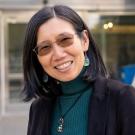The Nexus of Learnings
ECE senior design projects’ hands-on learning experience puts students’ engineering and life skills to the test
Regardless of their senior design project focus–whether it was on plants, self-driving cars, robots or flying cows–this year’s group of electrical and computer engineering seniors said perseverance, problem solving, project management skills and teamwork were the most valuable takeaways they experienced as part of this year’s senior design projects.
The ECE senior design projects are a hands-on learning opportunity for soon-to-be ECE graduates and the culminating project to integrate what they’ve learned in the classroom. The 20-week courses allow students to learn how to complete a capstone project in which they design and prototype a product, device, process or software system.
Learn more about the 2022 award-winning projects and the student teams behind them.
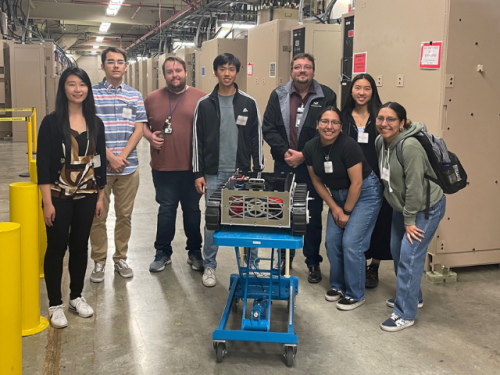
Hawkeye Inspection Robot for National Ignition Facility at Lawrence Livermore National Lab
Vanessa Liera, Victoria Liera, Devon Liu, Jocelyn Park, Brian Shimabukuro, Dzmitrij Sysou (Instructor: Raj Amirtharajah)
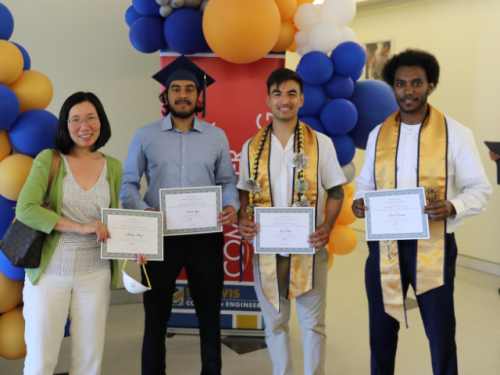
The Utilization and Implementation of Computer Vision in Autonomous Vehicles for Object Detection and Avoidance
Abraham Hadaf, Ameek Nijjar, Jared Velasco, Samuel Demissie (Instructor: Chen-Nee Chuah)
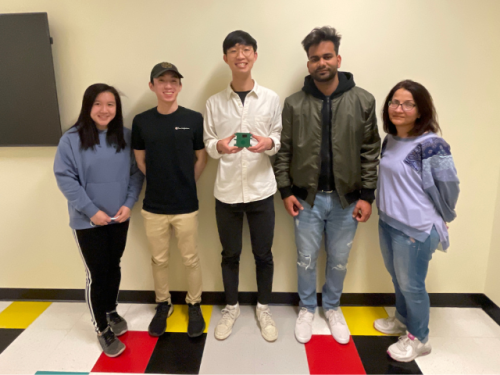
Growful - A Smart Houseplant Monitor
Vincent Huynh, Justin Lee, Ankit Ohri , Parinaz Mahrouyan, Christina Zheng (Instructor: Raj Amirtharajah)
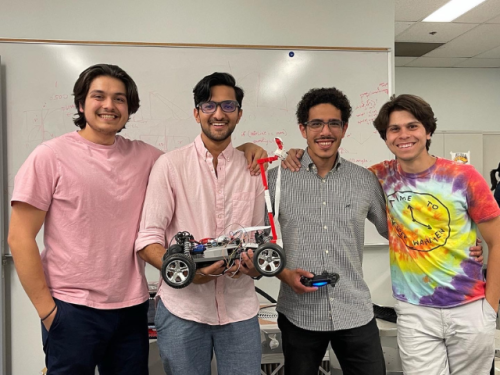
Autonomous Vehicle
Abdallah Hashem, Upamanyu Kashyap, Samuel Miller, Ralph Shehayed (Instructor: Lance Halsted)
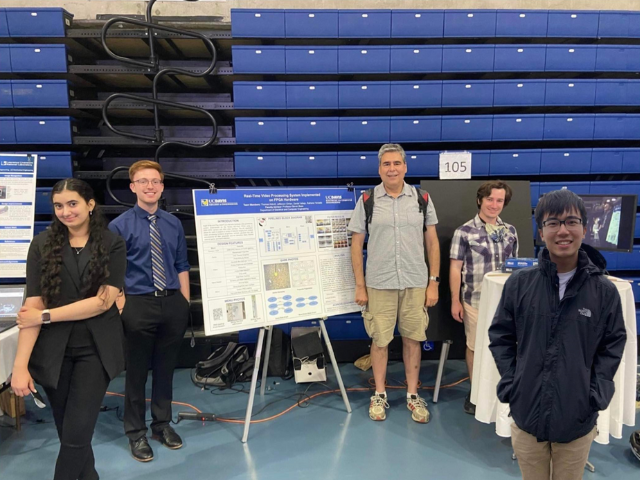
AggieSnapAndPlay (ASAP)
Thomas Abbott, Jefferson Chhen, Raihana Yarzada, Daniel Vallejo (Instructor: Bevan Baas)
Hawkeye Inspection Robot for National Ignition Facility at Lawrence Livermore National Lab
Tracks falling off. Motors breaking. Burning “the brains of the robot.”
Those are just some of the challenges Jocelyn Park ’23 and her team had to overcome as they worked to build a robot for Lawrence Livermore National Lab as part of their senior design project. The team was charged with building a robot that could inspect the capacitor bay before, during and after 192 lasers had been fired in the National Ignition Facility. The goal of the robot is to autonomously drive around the capacitor bay, take images, identify any abnormalities with the system and send an alert to the engineers.
This year’s team had the advantage of building off of the work of last year’s team who had the same project and constructed the robot’s chassis. This year’s team focused on the mechanical design aspects of the robot, generating a map of the environment for autonomous navigation, creating a graphical user interface, implementing safety features and fixing the various problems they encountered along the way.
“We learned there are reasons there are safety features and that we need to keep them in place,” team leader Park said with a laugh. “But, yeah, most of our time from January to June was spent fixing our robot.”
Despite these challenges, the team persevered. They divided up duties and focused on things that could move forward while other teammates worked on fixing other aspects of the robot. They also learned the importance of listening to a client, in this case Lawrence Livermore, when designing something.
“We had weekly meetings with them and we knew we couldn’t say, ‘We couldn’t do anything this week because we were too sad about our robot breaking,” said Park, who obtained a summer internship with Lawrence Livermore because of this project. “So it helped motivate us to keep going. I don’t know if any of us would have been able to learn how to manage a relationship with a client if we were in another senior design project.”
The Utilization and Implementation of Computer Vision in Autonomous Vehicles for Object Detection and Avoidance
YOLO is what inspired Abraham Hadaf ’22 and his team’s senior design project.
Not the You-Only-Live-Once social media hashtag; but rather, a state-of-the-art, real-time object detection system called You Only Look Once.
“We wanted to utilize a project with the latest version of YOLO and try and implement that in a real-life car example,” Hadaf said.
Hadaf and his team built a self-driving car that could detect a stop sign and adjust the throttle of the car and the accuracy of where the car stopped based on its proximity to the stop sign. It also was able to avoid collisions with people based on where the person was. For example, the car would turn left if a person was in the way of the car on its right side. This was done by calculating the bounding box dimensions of YOLO when YOLO detected a person. Hadaf said that he and his teammates learned a lot of software, hardware skills and coding skills they didn’t have before, including coding with machine learning, “which was a whole new world for all of us,” Hadaf said.
Hadaf added that he was able to use this senior design project as an example to demonstrate various skill sets during several job interviews and helped him obtain a job after graduation.
“There were real-world applications that we implemented, and that kind of education is very valuable,” he said. “Without this class, I wouldn’t have received that knowledge.”
Growful - A Smart Houseplant Monitor
Do you love having houseplants, but lack a green thumb? Then, you could use this senior design team’s invention.
Vincent Huynh ’22 and his team developed a micro-controller-based indoor irrigation system called Growful that measures relative humidity, ambient temperature and soil moisture to know when to automatically water your house plant when it gets too dry.
The device, which is about the size of a portable hard drive, is placed into a pot and can be managed through a person’s smartphone. To operate, the user inputs the volume of the pot and the minimum moisture level they want for the plant. The device takes a measurement of temperature and humidity every five minutes, as well as a soil moisture reading every hour. If the measured soil moisture drops lower than the requirements the user requested, the device will activate a water pump that will water the plant for a time period that is determined by a proprietary algorithm the team developed and programmed into the device.
“We drew inspiration for the project from our time in quarantine where we knew a lot of people got houseplants,” said team leader Huynh. “So we wanted to create a device that would help them manage their devices more easily and efficiently.”
Huynh said the team had to learn a litany of skills to create the device: printed circuit board (PCB) design, coding, soldering and programming on top of communication skills, organization and teamwork.
“One of the biggest challenges we had to overcome was finding a way to work on all channels of the project in parallel and, in the end, seamlessly integrate all aspects of the project into one final project,” Huynh said.
Not only did the team win Outstanding Senior Design Project for their class, they presented the project at the Engineering Design Showcase and the Electrical and Computer Engineering Expo. They also entered it into the 2022 Little Bang! competition hosted by the Mike and Renee Child Institute for Innovation and Entrepreneurship and UC Davis Graduate School of Management. The team won two Little Bang! awards.
“For me, and similar to a lot of other seniors, completing a senior design project is a pretty big milestone in your academic career, especially for engineering,” Huynh said. “You take what you learned in the past four years and apply it into this culminating project. It’s a reflection upon how much I’ve learned in the past four years and of how much I’ve grown as a person and as an engineer.”
Autonomous Vehicle
It was the home stretch of their senior year. Abdallah Hashem ’22 and Upamanyu “Upa” Kashyap ’22 were walking toward Kemper Hall with pillows and blankets in hand, ready to spend the night in the lab, if needed, to finish their senior design project. It was down to the wire. Not because they procrastinated, but because of how precise the machine needed to be for success.
Their goal was to build an autonomous vehicle that stayed between lanes, avoided obstacles and went as fast as possible.
The team worked long hours on optimizing their code so that the coding could run fast enough to make good decisions as the car traveled at speed. They also had to optimize the hardware components of the car, such as the camera, so that it would complement the software and the speed of the coding.
“So essentially there was this sweet spot of how fast we could run it. It was really a process of trial and error,” Kashyap said. “We put in quite a few hours into making sure it could work in those exact conditions. In the end we created something we were all really proud of.”
The team developed a car that not only stayed within the lines, but also traveled at speeds up to 12 miles per hour. Their efforts earned them the best senior design project of their ECE class.
“The best thing I’ve learned is being able to work as part of a team,” said Hashem, who started a position at Qualcomm a few days after graduation. “Everyone has their own perspective on things. We learn collectively to help appreciate each other’s ideas and be ready to accept any idea that would help our project get where it needs to be.”
Kashyap added that he also appreciated being able to apply four years of learning through this project.
“It was like the nexus of all those classes, that was the essence of this project,” said Kashyap, who also has a full-time position at Qualcomm. “The techniques of problem-solving, design, past learnings, they all beautifully combined through this project. This, by far, is the largest scope project that I’ve worked on during my time in college and I really enjoyed bringing it all together in that final part of my degree.”
AggieSnapAndPlay (ASAP)
While pigs flying typically describes impossibility, cows flying is an apt description of one of this year’s award-winning senior design projects called AggieSnapandPlay, or ASAP for short.
ASAP is a real-time video processor that uses digital logic–a fundamental concept underpinning all modern computer systems–to enable different augmented reality features on a monitor.
The features the team implemented were a series of filters similar to those used on social media platforms, including colors, brightness, contrasts, a Gaussian blur and a Sorbel edge-detect filter–the last of which is one of the basic principles used in motion detection.
“When we describe these filters, if someone was good at coding, you would think this project is kind of trivial,” said ASAP team leader Thomas Abbott ’22. “The trick is, we didn’t write software to do this. We could have done that in a week or two. We wrote the hardware in a digital circuit down to the gate level. Because of that, the circuit ran 12,931% faster than traditional computers.”
As impressive as these coding accomplishments are, the filters were part of the assignment’s requirements. What made Team ASAP really stand out was when they took their design further–into a bovine stratosphere to be exact.
Inspired by the 1980s video game Asteroids, the team created a video game that uses a camera to track a tennis ball, which in turn moves a cursor on the screen. The tennis ball is the player's controller as they move the cursor, trying to avoid a cacophony of cows flying around the screen. If a player hits a cow, the game is over; if the player survives a minute without knocking into any airborne heifers, then a celebratory message is displayed.
To create the Aggie-inspired game, the team had to develop a custom wand algorithm that included dynamic calibration that factored in shadows, lighting and the tennis ball’s shape to fine tune the responsiveness of the ball as a cursor. Additionally, instead of coding these features into software, the team had to do all coding to the systems hardware minimizing the input display to 1/60th of a second. The team also created a menu feature in their system which could be used to toggle the previously described filters, select the difficulty of the game and start the game.
“When you're sitting there on your bedroom floor dragging a tennis ball around on the carpet for 15 hours to get it just right, it’s then amazing to see some kid pick up that tennis ball and wave it around, and play like it's an iPhone game and it works perfectly,” Abbott said about the experience of presenting ASAP at the College of Engineering’s Engineering Design Showcase. “That was super rewarding.”
Abbott said another positive experience of the class was witnessing all the final presentations from his fellow senior design classmates.
“It was kind of crazy how many different, unique ideas people had for this project,” Abbott said. “That was the beauty of keeping the project open ended. To be able to see that your peers are doing great things is, on one hand, humbling, but also really rewarding–that UCD has really given us a great education and enabled us for success in the future.


